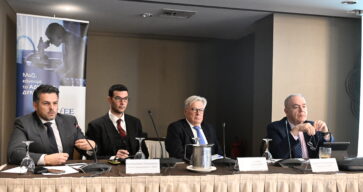Commission’s Pharma-legislation proposals risk Europe losing a third of its share of global R&D by 2040
New research shows Europe could lose 8% of total pharmaceutical innovation in the next 15 years
The European Federation of Pharmaceutical Industries and Associations (EFPIA) is publishing new research which assesses the impact of the European Commission’s draft Pharmaceutical Legislation on Europe’s competitiveness, the future of its innovative life-science sector and patient care.
While the Commission has committed to carrying out a European competitiveness check on future legislation it has not done so for the pharmaceutical legislation. Considering its impact on one of Europe’s largest and most strategically significant industries, EFPIA commissioned the Dolon consultancy to undertake a comprehensive competitiveness check on the proposed legislation.
The research analyses the impact of the Commission’s proposals across a number of areas, including EU innovation, competitiveness, impact on small and medium-sized enterprises (SMEs), patient access and environmental links.
The research shows that the Commission’s plans would hasten a trend which has seen Europe’s position as a global innovator deteriorate further in comparison to leading nations, the USA, China and Japan.
The data shows that the Commission’s proposals to reduce regulatory data protection (a vital component of intellectual property, for a large number of breakthrough medicines) reduces the incentive for companies to invest in these medicines by 55% in Europe over the next 15 years. This translates into a significant impact on European innovation and competitiveness.
The Commission proposals are expected to escalate a trend which has already seen Europe lose a quarter of its global R&D investment in the last 20 years. The findings show:
- Europe’s share of global R&D investment is predicted to reduce by a third (from 32% of global R&D expenditure to 21%) by 2040.
- Equating to €2 billion in lost R&D investments each year
- One in five (22%) projects to research and develop regulatory data protection (RDP) reliant medicines would no longer be economically viable in Europe.
- This corresponds to an 8% drop in Europe’s total pharma innovation.
- This could see the research and development of around 50 out of 225 expected new treatments foregone over the next 15 years – medicines which may not be researched elsewhere.
- A loss of this amount of innovation is estimated to translate to 16 million years of life lost (YLL)* through increased mortality and premature death across the EU.
Europe’s biotech sector – SMEs – would be most impacted by the proposals, worsening a situation which is already seeing Europe’s biotech base moving to the more predictable financial ecosystems in the US and China. The research shows that nine out of ten biotech research projects for RDP reliant medicines would at risk, due to being no longer economically viable.
More than one in three medicines rely on RDP as a last-to-expire protection. It is particularly important for advanced, complex therapeutics with a long or difficult development time, where other protection filed for at the outset of research has lapsed.
The European Commission proposals to modulate incentives for orphan medicines will disproportionately hit research for the 1.5 million patients with a rare disease. Under the proposals, Dolon estimated (in a previous report) that the deterioration of the research ecosystem will lead to:
- The loss of 45 new treatments for rare diseases which may not be carried out elsewhere
- 5 billion Euros of research lost to Europe.
Additional EFPIA research suggests that proposed tightening of the definition of ‘unmet medical need’ (UMN) means that only 18% of products recently developed would meet the stringent criteria, with a heavy impact felt in areas including cardiovascular disease, diabetes and HIV.
As the Legislation passes through the European Parliament and Council, Industry is asking policy makers to scrutinise the impact that the proposals would have on individual Member States.
In 2010, Europe accounted for 37% of global R&D; in 2020 that had dropped to 32%. The new research projects that by 2030 that figure would have dropped further, to 25%, and by 2040 to just 21% of research and development activity compared with the other regions. Meanwhile, China’s contribution is expected to leap from 2% in 2010 to 17% in 2040.
The science base in almost all member States would be impacted negatively. The report provides an estimate of the amount of annual R&D revenues likely to be lost to each Member State if the Commission’s proposals went ahead in their current form. Figures show:
- Germany is set to be hit hardest, losing around €626 milllion every year.
- Belgium missing out on R&D projects worth €381million and France €326 million
On top of the pharmaceutical legislation proposal, several legislative proposals stemming from the Green Deal will have a substantial impact on pharmaceutical sector operations and are specifically linked to the general pharmaceutical legislation environmental risk assessment. Their cumulative impact could have unintended consequences on the availability, affordability and accessibility of medicines. Some of the proposed measures could be even more detrimental if implemented without adequate adaptations, such as a blanket ban on PFAS.
Even less drastic environmental measures would compound the detrimental effect of RDP modulation on innovation. The Dolon modelling suggests that heightened environmental requirements could halve the number of RDP-reliant medicines viable to be researched in the EU, with the regions potentially losing 124 of 225 products within the next 15 years if manufacturing costs were to significantly increase.
EFPIA President and Chief Executive of Novo Nordisk, Lars Fruergaard Jorgensen, said:
“Policymakers in the EU regularly say that they want to enhance European competitiveness and make Europe a strong global player by ensuring open strategic autonomy. However, overall, the measures currently being considered in the pharmaceutical legislation are likely to harm, rather than strengthen, our joint ability to achieve these goals. This will have a negative impact on the European economy, and most importantly on the lives of millions of people in Europe who need innovation in medicine to transform their lives.”
EFPIA Director General, Nathalie Moll, said:
“EFPIA warmly welcomed President von der Leyen’s announcement that competitiveness checks would be carried out ahead of legislation being developed. However, given that the pharmaceutical legislation has not yet been subject to this, industry has undertaken the work. The data makes for sobering reading for patients, health systems, Europe’s scientific community and any Member State with life science ambitions.
To close the gap on other regions of the world Europe needs to strengthen, rather than erode, its IP protections for new medicines and vaccines. Trying to legislate an industry into staying in any region does not work. Instead, we have to create the conditions in which companies chose to invest in research, development and manufacture in Europe”
Notes to editors
Incentives. The Commission proposes to reduce baseline RDP duration for new medicines from eight to six years, with various possibilities for extension: EU market launch (+2 years); addressing unmet medical need (+6 months); comparative clinical trials (+6 months); new therapeutic indication (+1 year; as current).
This report was commissioned and funded by the European Federation of Pharmaceutical Industry Associations (EFPIA). The conceptual framework, model structure and parameters were developed by Dolon, with input from EFPIA.
The modelling relies on risk-adjusted net present value modelling (rNPV) – which analytically represents how biopharmaceutical companies make investment and launch decisions and is consistent with previous studies – to assess the potential impact of legislative changes.
* Years of life lost (YLL) is a measure of premature mortality that takes into account both the frequency of deaths and the age at which it occurs.
A slide deck summary of the report is available here.



